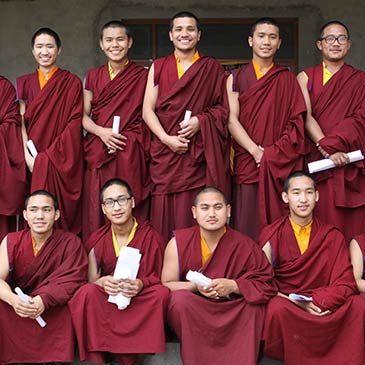Primary and Secondary education
Primary Education

Upon first entering the monastery, young monks typically begin their new life’s journey by acquiring the basic knowledge and skills that will be most needed throughout their future spiritual and worldly endeavors.
The majority of monks join Ka-Nying Shedrub Ling between the ages of ten to fifteen and already have a degree exposure to public education. They enter the monastery’s primary school that consists of five years both focused on subjects in line with Nepal’s public education system and training in the most basic skills required of a monk.
At present there are 160 monks engaged in primary education at Ka-Nying Shedrub Ling. They study the Tibetan, English, and Nepali languages, alongside subjects such as history, civics, and religion. There is also an emphasis on memorizing the basic prayers and liturgies commonly used in the monastery’s chanting tradition. Teachers are both monastics and lay individuals. Young students also participate in the major ceremonial events of the monastery, and will occasionally go on picnics and other excursions. Regular health checks are performed in the monastery’s clinic, which is staffed by professional doctors and nurses.
As the monastery has committed to providing for all the practical and spiritual needs of its initiates, primary education is seen as essential to the future growth of the monastery as a whole. In this vein, the monastery strives to ensure that its young children have a safe, healthy, and loving environment.
Construction of a new area for the young monks has recently been completed, as after the earthquakes of 2015, the monastery received about 100 new young monks and more housing was needed. Now the young monks have an area just for them that includes dormitories, classrooms, recreation rooms, and a spacious, safe place for them to run around and play during recess time.
Secondary Education

Upon completing their primary education, monks enter the so-called middle school in which, alongside becoming active participants in the entirety of the monastery’s activities, students also begin to embark on more advanced studies.
It is during this stage that monks are expected to become proficient in all aspects of Vajrayana Buddhist ritual. This includes creating and arranging offerings, playing the various traditional instruments, chanting and conducting pujas. This is accompanied by three years of classes emphasizing grammar, composition, and the introductory texts of Buddhist philosophy. In taking up the full duties of monastic life, these students will also aid older lamas in the various services they perform for the local Buddhist lay community.
At present, there are approximately 40 monks studying at this level ranging in age from sixteen to twenty-one.